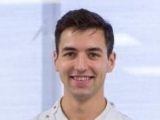

There is a large divide between data scientists and clinicians, which has the potential to hinder scientific progress in healthcare.
 Matthieu Komorowski, Clinical Research Fellow in Intensive Care and PhD student in the Department of Surgery and Cancer, has collaborated with Massachusetts Institute of Technology (MIT) to produce a book that aims to bridge the gap between these two disciplines. Since its release in September 2016 the publication has received over 54,000 downloads. As co-author on three chapters and co-editor for one of the sections, Matthieu explains more about the book, his work and the collaboration with MIT.
Matthieu Komorowski, Clinical Research Fellow in Intensive Care and PhD student in the Department of Surgery and Cancer, has collaborated with Massachusetts Institute of Technology (MIT) to produce a book that aims to bridge the gap between these two disciplines. Since its release in September 2016 the publication has received over 54,000 downloads. As co-author on three chapters and co-editor for one of the sections, Matthieu explains more about the book, his work and the collaboration with MIT.
Why is the divide between data scientists and clinicians such a problem?
With the advent of digital patient records, people have come to realise the tremendous potential of using electronic health records to improve medical care. But before that, and for historical reasons, the worlds of computer science and medicine have been completely separated. It means that nurses and clinicians know little about things like biostatistics, health IT and machine learning, and data scientists don’t comprehend the challenges of day-to-day clinical care. Only a tight collaboration will lead to the development of innovations that are meaningful for the clinicians, perfectly integrated in their workflow and altogether methodologically sound.
What outcomes can come out of bringing these disciplines together?
As well as developing clinical focused technology, useful tools can be created when medical professionals and IT specialists collaborate and target local challenges. My laboratory at MIT regularly organises health bootcamps (“hackathons”), with the specific goal of encouraging partnership between ICT and medical professionals, in particular in the field of mobile health applications in the developing world. In 2015, the lab organised such a hackathon in Uganda, a country where adolescents face significant healthcare concerns, including risk of adolescent pregnancy, unsafe abortions, HIV and intimate partner violence. Over the course of a weekend, the teams developed mobile health applications that provide services or information about sexual and reproductive health to local populations, something far more valuable than a useless feature in an expensive medical device.
What are the aims and intention of the book?
The book is intended for both data scientists and clinicians. Its specific purpose is to help bridge the gap that divides those two disciplines and currently somewhat hinders scientific progress in healthcare. It will teach physicians about data analytics, and computer scientists about healthcare, so both can better collaborate and generate new medical knowledge from medical records. It is offered in open access in order to reach an audience as large as possible.
Tell us more about the sections of the books you contributed to?
I was co-editor of the second section of the book, which really is a step-by-step guide to health data analytics. This section takes you from formulating your research question, to building your cohort, to extracting the data and performing your analyses, and finally to report them. “Practice makes perfect”, and one of the assets of the book is that it’s very hands-on. We provide a de-identified dataset on which you can try all the code provided in the book, in the R programming language. We have used this formula very successfully during the new course with MIT students in the last months.
How did the collaboration with MIT come about?
I have been collaborating with the Laboratory of Computational Physiology at MIT since the very beginning of my MRes in Bioengineering at Imperial College, in 2014. I have used their open database (MIMIC) for my research and have grown close ties with Prof Leo Celi, the lead of the MIMIC project. I helped co-organise datathons (coding competitions) in London in 2014 and 2015, and we also worked together on various grant applications. I eventually received a formal invitation from Prof Celi to join the lab during my PhD. I am staying here at MIT for six months and my visit here was made possible by my Imperial College President’s PhD scholarship, for which I am extremely grateful.
What are you currently researching?
I am currently doing a PhD and have a research fellowship in intensive care at Charing Cross Hospital. In my research, I combine my expertise in machine learning and critical care to generate new clinical evidence and build the next generation of clinical tools. These include decision support systems, with a particular interest in septic shock, the number one killer in intensive care and the single most expensive condition treated in hospitals.
Do you think that it’s important for clinicians to become involved in research?
In my opinion, it makes a lot of sense for clinicians to become involved in research. Being at the bedside and treating a patient is not the right time for improvisation and creativity. On the other hand, research allows us to think forward, to imagine how we could improve our practice beyond the current state of the art.
What are your plans for the future?
Following my PhD, my plans are to reach an academic position that will allow me to practice in the intensive care unit whilst continuing my research in healthcare data analytics. My vision is to work towards developing hospitals where “intelligent” tools are embedded at the bedside, trusted by everyone, from patients to nurses and consultants and used every day to improve medical decisions and patient outcomes.
Read more on Matthieu’s book Secondary Analysis of Electronic Health Records.
Article text (excluding photos or graphics) available under an Attribution-NonCommercial-ShareAlike Creative Commons license.
Photos and graphics subject to third party copyright used with permission or © Imperial College London.
Reporter
Kathryn Johnson
Department of Surgery & Cancer

Contact details
Email: press.office@imperial.ac.uk
Show all stories by this author



